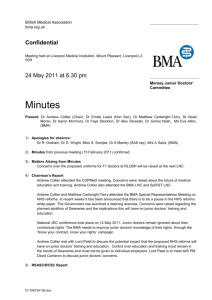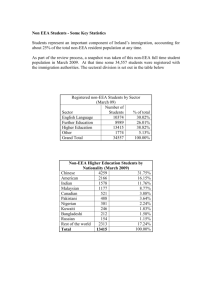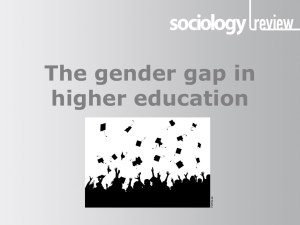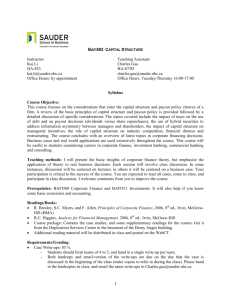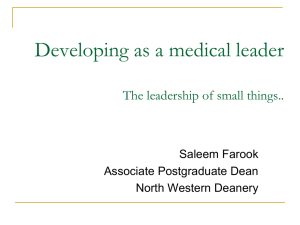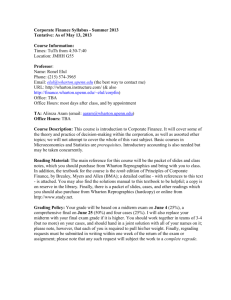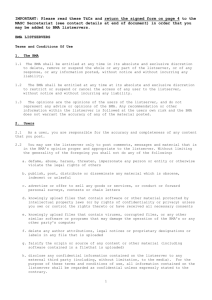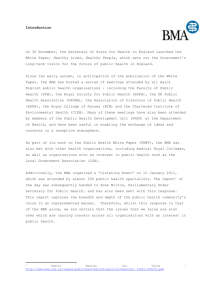Inquiry into International STEM students – Memorandum of
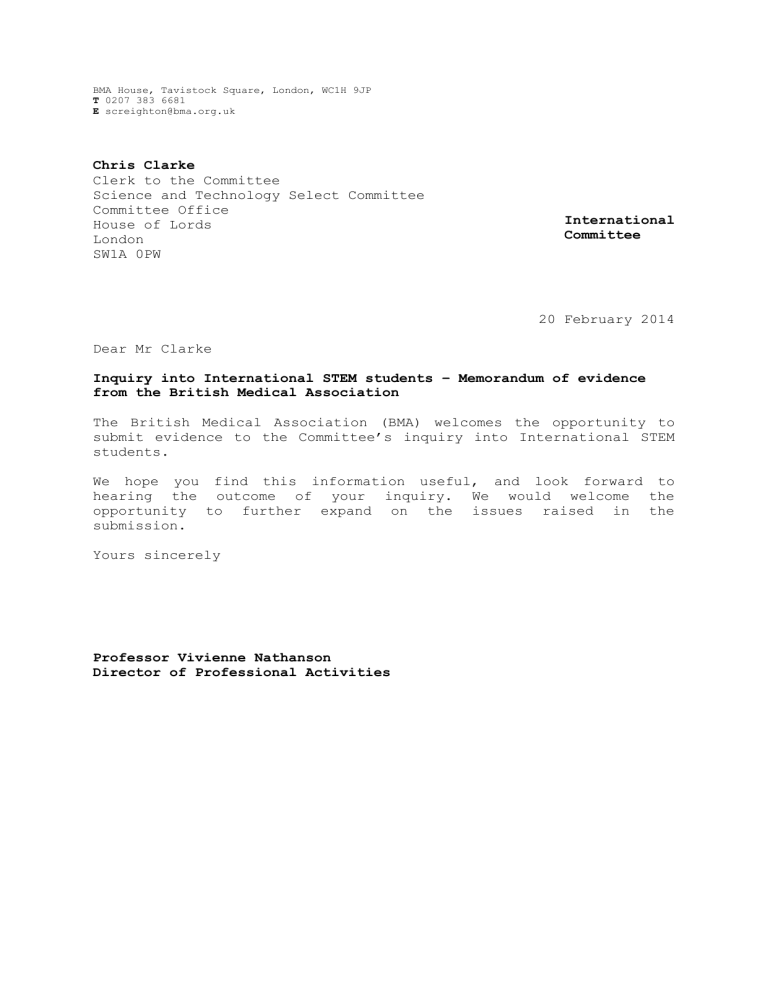
BMA House, Tavistock Square, London, WC1H 9JP
T 0207 383 6681
E screighton@bma.org.uk
Chris Clarke
Clerk to the Committee
Science and Technology Select Committee
Committee Office
House of Lords
London
SW1A 0PW
International
Committee
20 February 2014
Dear Mr Clarke
Inquiry into International STEM students – Memorandum of evidence from the British Medical Association
The British Medical Association (BMA) welcomes the opportunity to submit evidence to the Committee’s inquiry into International STEM students.
We hope you find this information useful, and look forward to hearing the outcome of your inquiry. We would welcome the opportunity to further expand on the issues raised in the submission.
Yours sincerely
Professor Vivienne Nathanson
Director of Professional Activities
EVIDENCE FROM THE BRITISH MEDICAL ASSOCIATION FOR THE LORDS SCIENCE
AND TECHNOLOGY COMMITTEE INQUIRY INTO THE INTERNATIONAL STEM
STUDENTS
About the BMA
The British Medical Association (BMA) is an independent trade union and voluntary professional association, which represents doctors from all branches of medicine throughout the UK. It has a membership of over 153,000 doctors and medical students.
Introduction
1.
Much of the rhetoric about immigration has focused on the pressures that increased migration has placed on public services including the health service, housing and schools. The debate frequently fails to acknowledge the significant impact that highly skilled migrants such as doctors have played, and continue to play, in delivering and sustaining public services including the NHS and our universities.
2.
The BMA believes:
Debate on immigration policy must acknowledge the significant impact that highly skilled migrants, including doctors, have played, and continue to play, in delivering and sustaining public services including the NHS and our universities
Any changes introduced to the immigration rules must provide medical students and doctors already committed to studying and training in the UK with a clear pathway through the training system
There should be no retrospective implementation of visa rules that negatively impact on the lives of overseas medical students and doctors.
International Medical Student numbers
3.
There are approximately 3,000 non-EEA students studying clinical medicine in the UK. International (non-EEA) admissions to UK medical schools are subject via the Higher Education Funding Council (HEFCE) to a Department of Health cap of 7.5 per cent of total admissions.
The purpose of this cap is to manage NHS workforce supply and demand and to prevent a situation where public funding of medical education is spent on preparing a large body of international students who may then leave the NHS and return fully trained to their countries of origin.
4.
The BMA believes the cap is required and is set at the right level. We are supportive of international medical students coming to the UK as a vital part of the student intake contributing to universities and the local economy. We also believe that this needs
to be balanced with also encouraging UK nationals to study clinical medicine and ensuring they are not prevented from progressing through medical training programmes. Graduate doctors, upon completion of an undergraduate medical degree (typically lasting five to six years), must complete the two-year UK Foundation
Programme in order to achieve full General Medical Council (GMC) registration which is required to practise as a fully qualified doctor. The Foundation Programme is designed to build on the knowledge and skills gained during undergraduate training.
5.
For four years, the predicted number of graduates from UK medical schools has exceeded the number of available places on the UK
Foundation Programme, causing the programme to be oversubscribed. In order to tackle this issue, the Government has previously made commitments to ensure that all graduates are offered a place on the
Foundation Programme 1 and essentially provided additional funding to provide posts. With this problem set to continue, discussions are ongoing about a long term solution to this problem. The BMA therefore believes that the cap is essential to prevent exacerbating the problem even further.
6.
The BMA also believes that career progression and immigration prospects for non-EEA medical students need to be clear and transparent from medical school admission through to completion of postgraduate training.
Impact of Tier 2 (General) Resident Labour Market Test and graduates of UK universities
7.
International medical students and doctors in training have a very different experience of UK undergraduate and postgraduate education than that of their counterparts in many other disciplines.
The medical degree is the first stage in a lengthy period of training. As highlighted above, the immediate priority of the degree is to prepare the student for the Foundation Programme, which in turn provides the doctor in training with the practical experience needed to make an informed decision about specialisation.
8.
Non-EEA students make up to 7.5% of those studying in programmes in clinical medicine at UK universities. Such students also make significant contributions to their local economies in the UK through living and accommodation expenses. Also during the two foundation training years, these graduates will have paid tax and made national insurance contributions. It should also be recognised that these students have made these commitments with the wholly reasonable expectation of embarking upon specialty training.
9.
We are aware of anecdotal evidence suggesting that overseas graduates of UK universities are now facing barriers in progressing their training. These relate to the impact of the Resident Labour
Market Test (RLMT) on UK graduates applying for specialty training both straight from the Foundation Programme and following completion of Core Training. Once they hold a Tier 2 visa, they can only apply for a specialty training programme in Round 1 if that programme is covered by their current visa sponsor, e.g. those sponsored by the
West Midlands Deanery can apply for a programme in the West Midlands
Deanery through Round 1 but they would not be able to apply for any other programme elsewhere in the UK unless it is through Round 2.We
are very concerned about the rules having this impact and the possible effect this may have on the levels of overseas students coming to the UK to study. At this time, we have no statistical information to ascertain the extent of the issue which is concerning. Local Education and Training Boards 2 would probably be in the best position to collect this data. The BMA has consistently argued for immigration changes to be based on sound statistical evidence.
10.
It costs in the region of £269,000 to train a newly qualified doctor in the UK and in addition to this the NHS makes a significant investment in terms of the salary paid to those who undertake the
Foundation Programme 3 . There is a real risk that some of the most competent and talented UK-trained non-EEA doctors applying for specialty training will therefore be lost to the NHS. With no alternative immigration category open to them, this could mean that the NHS could potentially lose out on the cost of training and the benefit of the investment made annually in Foundation Programme salaries (£39 million 4 at present).
11.
Graduates of UK universities have already been included in current medical workforce planning. The forecasts which have been made for the next few years cannot predict how many of these students will enter specialty training or indeed stay in the UK. For those that do, it is impossible to predict in which branch of practice they will work and in which UK location. These are key considerations as there is sizeable variation in recruitment across the spectrum of specialties; some will have surpluses, others will experience shortages. Workforce requirements at local, regional and national levels are also subject to similar degrees of variation.
The BMA believes that the immigration rules should be responsive to the potential for medical workforce needs to vary according to medical specialty and/or geographical location and allow for appropriate adjustments to be made by those responsible for training and service delivery
12.
Overseas students are a valued income stream for higher education institutions and help support teaching and research in other parts of the institutions. Prospective students from outside the EEA may well select other destinations to undertake their medical studies due to the limited opportunities now afforded to them in the UK beyond the Foundation Programme. If there was a resulting decline in non-EEA medical students in the UK below the set cap, there would be a sharply reduced income for individual medical schools through the loss fees paid by this group of students
(between £25,000 and £35,000 per year for an individual student depending on the medical school).
References
1 House of Commons, Hansard, 14 Jan 2013 : Column 621W
2 Local Education and Training Boards (LETBs) are organisations authorised by Health
Education England to be responsible for the training and education of NHS staff, both clinical and non-clincical, within their area.
3 The Foundation Programme is a two-year postgraduate training programme, the first year of which is compulsory in order to gain full registration with the General Medical Council
4 Figure based on the 2009 calculation that trainees are paid an average of £74,200 over the two-year Foundation Programme multiplied by 525, the number of non-EEA doctors entering the
Foundation Programme each year.

